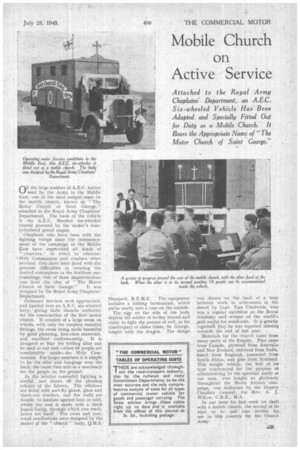Mobile Church on Active Service
Page 31

If you've noticed an error in this article please click here to report it so we can fix it.
Attached to the Royal Army Chaplains' Department, an A.E.C. Six-wheeled Vehicle Has Been Adapted and Specially Fitted Out for Duly as a Mobile Church, It Bears the Appropriate Name of "The Motor Church of Saint George."
Othe large number of A.E.C. lorries used by the Army in the Middle East, one of the most unique must be the mobile church, known as "The Motor Church of Saint George," attached to the Royal Army Chaplains' Department. The basis of the vehicle is the A.E.C. Marshal six-wheeled chassis powered by the •maker's fourcylindered petrol engine.
Chaplains who have been with the fighting troops since the commencement of the campaign in the Middle East have impeovised all kinds of " churches," in which to celebrate Holy Communion and conduct other services; they.have been faced with the greatest difficulties in creating the desired atmosphere in the drabbest surroundings. Out of these improvisations was born the idea of "The Motor Church of Saint George." It was designed by the Royal Army Chaplains' Department.
Ordnance Services were approached, and handed over an A.E.C. six-wheeled lorry, giving carte blanche authority for the construction of the first motor church. It consists of a large room on wheels, with only the simplest essential fittings, the room being, made beautiful by good planning, first-class materials, and excellent craftsmanship. It is designed so that the folding altar can be used at one end—when 10 people are comfortably inside—for • Holy Communion. For larger numbers it is simple to fix the altar and hangings near the back; the room then acts as a sanctuary for the people on the ground.
In the interior concealed lighting is restful, and shows off the pleaSing colours of the fabrics. The wihdows are fitted with anti-fly gauze, glass and black-out •shutters, and the walls are double, to insulate against heat or cold, whilst the roof is made with a thick kapok lining, through which two ventilators are fixed. The cross and rosewood candlesticks were designed by the maker of the " church " body, Q.M.S. Sheppard, R.E,M.E. The equipment includes a folding harmonium, which packs neatly into a case on the outside.
The sigp on the side of the body depicts the soldier of to-day braced and ready to fight the powers of evil, as his• counterpart of olden-times, St. George, fought with the dragon.' The design
was drawn on the back of a map between work in afternoons_ in the desert by Capt. Tom Chadwick, who was a regular exhibitor at the Royal Academy and winner .of the world's gold medal for wood-cuts. It is greatly regretten that he was reported missing towards the 'end of last year.
Materials for the church• came from many parts of the Empire. Pine came from Canada, plywood from Australia and New Zealand, redwood from India, beech from England, rosewood from South Africa, and glue from Scotland. This unique vehicle, the first of its type constructed for the .purpose of administering to the spiritual needs of our men, who fought so gloriously throughout the North African campaign, was dedicated by the Deputy Chaplain General, the Rev. A. J. Wilcox, C.B .E., MA.
In our issue for last week we dealt with a mobile church, the second of its kind to be put into service for. use in -this country by the Church Army.




















































